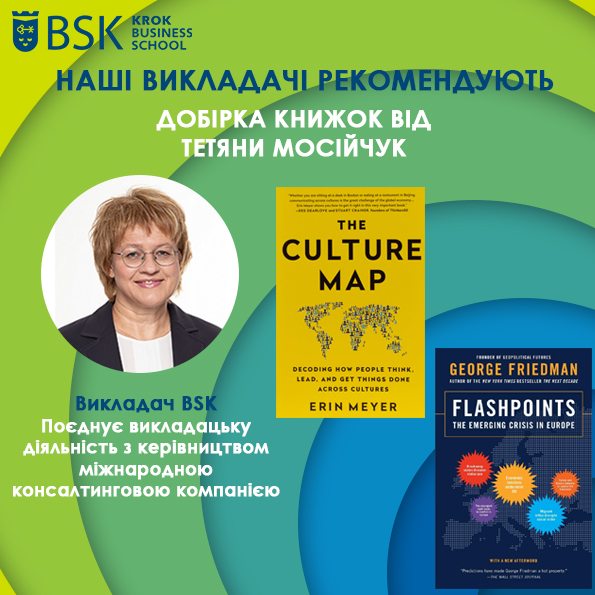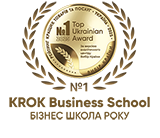For those interested in geopolitics and international business, Tetyana Mosiychuk, associate professor of the Department of Management and Innovative Development, recommends a selection of books "Flashpoints: The Emerging Crisis in Europe" by George Friedman and "The Culture Map" by Erin Meyer.
«Flashpoints: The Emerging Crisis in Europe» George Friedman
George Friedman is a political scientist, an internationally recognized geopolitical forecaster, the founder and ex-director of STRATFOR, as well as the founder and chairman of Geopolitical Futures.
With remarkable accuracy, George Friedman predicted future trends in world politics, technology, population, and culture. State agencies and big business used STRATFOR's geopolitical forecasts. In any case, all the materials prepared by J Friedman and his companies are extremely interesting because they reflect the strategy of the biggest geopolitical player in the world.
The book "Flashpoints: The Emerging Crisis in Europe" was published back in 2015, but it has not lost its relevance even now. Moreover, intellectuals and everyone on whom the future of Ukraine depends should be well aware of the geopolitical causes of the war, possible directions of development, as well as other potential points of tension in Europe, where tensions have arisen throughout history and where conflict may arise again.
In Flashpoints, J Friedman focuses on Europe: the history of the struggle for power and territory, the connection between culture and religion over the past five hundred years and up to now. Analyzing the most volatile borders of Europe and Russia, as well as the fault lines that have existed for centuries and been ground zero for many catastrophic wars, Jay Friedman illuminates the flash points that are smoldering again in an unprecedentedly personal way.
The modern European Union was created in large part to minimize the built-in geopolitical tensions that have historically torn it apart. From J Friedman's perspective, which draws on a combination of rich history and cultural analysis, this design fails. "Flashpoints" tells about the living history of Europe and explains with great clarity its most unstable regions: turbulent and constantly changing borders of countries, which separates the West from Russia; the ancient border between France and Germany; and the Mediterranean, which gave birth to Judaism and Christianity and became the center of Islamic life. The book touches on the causes and consequences of the migration crisis in Europe, the economic model of EU member states and the contradictions of their coexistence.
In "Flashpoints" you will find a fascinating analysis of modern Europe, as the politicians and leaders active in its pages continue to influence our lives today, this includes explaining the policies pursued today by Hungary, France, Germany and other European countries. Finally, the book is a view of Europe from the United States.
I also recommend this author's books: "The Next 100 Years: A Forecast of the Events of the XXI Century" and "The American Empire Forecast for
"The Culture Map" by Erin Meyer
Sometimes it seems to us that if we know our business well and were able to build a business in the turbulent environment of Ukraine, then this is enough for international business. Sometimes we understand that good language skills or professional translation are not enough to understand your foreign visitors. Whether you work in a home office or abroad, business success in our increasingly globalized and virtual world requires the skills to navigate cultural differences and decipher cultures that are foreign to your own. I learned my "lessons" in cross-cultural communication and long ago began to study this issue not only in practice, but also in theory, which is why I highly appreciate "The Culture Map" by cultural communication expert Erin Meyer.
In The Culture Map, Erin Meyer presents a framework (eight scales) for analyzing how cultures differ from your own, as well as practical strategies for mitigating any cultural misunderstandings. The scales can be used to analyze one culture against another and decode how culture affects your international cooperation.
I will give an example of the "low content-high content" scale. Are you annoyed by people who cannot get their point across clearly and directly? Is it possible in business communications to guess what your partner meant or what he is not saying about the decision he made (especially negative about your idea/project)? If you do not accept this style of business behavior, then you belong to a low-context culture and most likely do not know how to "listen to the air" or read between the lines. In many Asian cultures, including those of Japan, India, China, and Indonesia, people learn from childhood to receive messages that are conveyed implicitly, requiring the listener to be able to understand hidden meanings. Good communication here refers to subtle and multi-layered communication that can depend on a large subtext. Responsibility for the accurate transmission of the message is shared between the sender and the recipient. The same is true in many African cultures, including those of Kenya and Zimbabwe, and to a lesser extent in Latin American cultures (such as Mexico, Brazil, and Argentina) and European Latin-speaking cultures (such as Spain, Italy, Portugal).
The lowest context culture in the US. The traditional American rule of thumb for a successful presentation is: "First tell what you're going to tell, then present it, and then tell what you've told." This is the essence of the philosophy of low-context communication. If you have already learned this rule of presentation, consider that it will not work for you in Japan or China.
If we are from a low-context culture, we may perceive a high-context communicator as secretive, opaque, or unable to communicate effectively. On the other hand, if we are from a high-context culture, we may perceive a low-context communicator as someone who speaks inappropriately about obvious things and their speech comes across as primitive.
What if the team in your business consists of people from cultures of different contexts? How to establish effective cooperation? Read "The Culture Map", there are answers and many other interesting things. The book is easy to read and will be useful both to those experienced in international business and to those who want to expand their understanding of cultural differences for personal life.





















